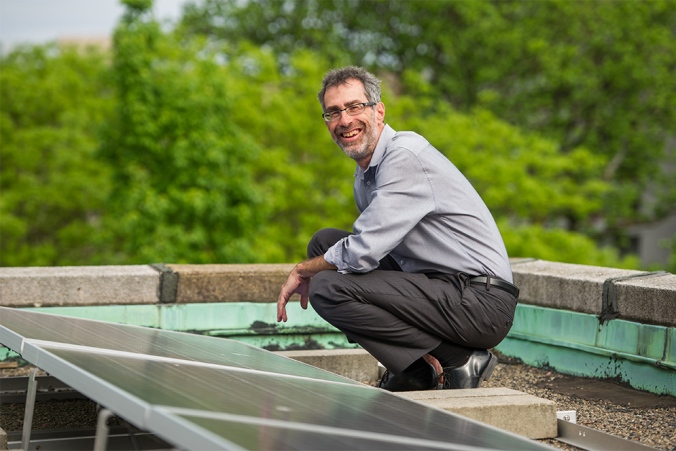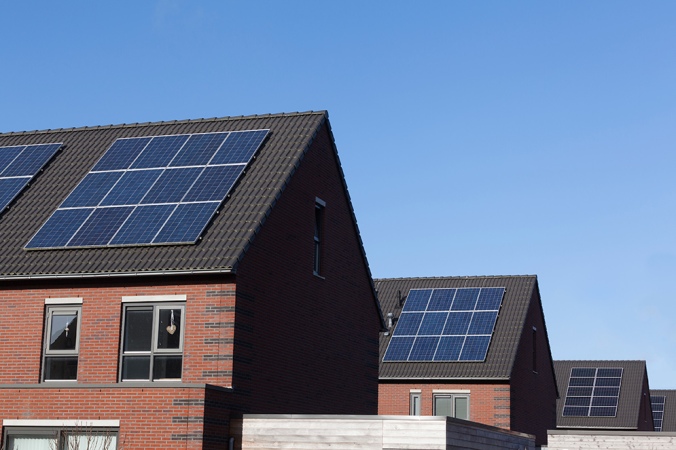It seems obvious that investing in renewable solar energy saves money for those who install photovoltaic (PV) systems for their homes. However, what might not be so obvious is that PV systems also reduce electricity prices for all those with no solar panels, as professor Robert Kaufmann from Boston University discovered. His research revealed that the approximately 40,000 households and community groups with solar panels in Massachusetts reduce electricity prices for all of the three million electricity ratepayers in the state, including those with no solar panels.
“Until now, people have focused on how much was being saved by those who owned PV,” says Kaufmann. “What this analysis quantified was that it actually generates savings for everybody.”
Kaufmann’s study, which was coauthored by Devina Vaid … looked at the ways that electricity prices and consumption, power plant efficiency, and PV capacity utilization are related to one another on an hourly basis. “We’re the first ones to really calculate system-wide savings on an hourly basis,” Kaufmann says. He notes in his paper that using an hourly average for electricity prices, rather than a daily average—as many past studies have done—is a more accurate way to quantify how PV systems affect electricity prices, because such prices fluctuate greatly throughout the day.
There are about one million solar installments—private rooftop, community, and commercial—in the United States, and they account for about one percent of the electricity produced in this country. With the cost of PV systems continuing to fall, that number is expected to double in the next two years, according to the Solar Energy Industries Association (SEIA), a nonprofit trade association. In 1998, the average price of a residential system was $12 per watt; in 2014, it was $4. (The number of watts on a rooftop system varies; the Hipplers’ system is 8,160 watts.) The SEIA ranks Massachusetts sixth among states for solar power generation, as measured by installed solar capacity; the state currently has about 1,020 installed megawatts (MW), enough to power 163,000 homes. Massachusetts Governor Charlie Baker has set a goal of 1,600 installed megawatts for the state by 2020.
Solar power systems save money for all ratepayers because they generate most of their energy during the hot summer months, says Kaufmann, when “everyone has their air conditioners running,” and demand for electricity is at its highest in Massachusetts. Utility companies, which obtain electricity from a variety of sources, must constantly balance customers’ supply and demand. As demand goes up—say, during the morning hours after people wake up and begin turning on their devices—the companies buy electricity from more and more power plants. They start with plants that can produce electricity most cheaply and move up to more costly plants from there. If demand gets high enough, Kaufmann says, “they have to turn to plants that do not operate very often per year because they’re relatively small, relatively inefficient, and their fuel costs are high” and “that really drives up prices.”
Here’s where solar energy comes in: When a PV system generates electricity, it goes directly into the grid, which is the network of connected power stations and transmission lines that brings electricity to individual customers. Utility companies can use the electricity from PV systems—which is highest in the summer months—rather than turning to those inefficient, more expensive power plants. By not turning on those expensive power plants, each kilowatt hour of electricity generated by PV systems reduces electricity prices by about 1 cent per kilowatt hour. (In 2015, residential customers were charged about 15 cents per kilowatt hour.)
These savings can be evaluated by comparing them to the subsidies that ratepayers make to owners of PV systems. One subsidy is termed a solar renewable energy credit (SREC). In order to receive SRECs, PV system homeowners [open] an account with the New England Power Pool Generation Information System (NEPOOL-GIS), an electronic registry run by APX, a California-based energy exchange company. The NEPOOL-GIS tracks the electricity generated by the PV system and issues an SREC for every 1,000 kilowatts (kW) it makes. An 8 kW system like the Hipplers’ should produce nine to ten SRECs a year, according to estimates from the Massachusetts Clean Energy Center, a government agency.
Homeowners can sell their SRECs to utility companies via online auction sites like SRECTrade.com, where the price is set by market forces of supply and demand, or at a special state auction at the end of the year. They also can use a broker/aggregator who pools SRECS from many PV system owners and sells them in bulk to utilities. In several states, including Massachusetts, utility companies have an incentive to buy SRECs because state law requires utilities to generate a percentage of their electricity from solar energy and other renewable energy sources. In Massachusetts, that number is 11 percent; it will increase by 1 percent each year until it reaches 15 percent in 2020.
Utilities purchase SRECs with money collected from all ratepayers in the form of a charge for renewables. Kaufmann’s study finds that this charge is about the same as the price reductions generated by PV systems. Each megawatt of electricity generated by PV systems in 2012 saved ratepayers about $303. This was about the same as the price for an SREC, $261 per megawatt. (Kaufmann used the 2014 SREC price). “Right now, it’s basically a wash,” Kaufmann says. “The savings generated by PVs basically cover the cost of the SREC, so in reality, consumers are paying nothing for the SRECs.”
Kaufmann’s study also notes that while the price savings that PV systems generate are about the same as the amount that consumers pay to subsidize SRECs, that dynamic will eventually change to the benefit of ratepayers. That’s because once the SREC program ends, sometime between 2020 and 2024, the savings that PV systems generate for all ratepayers will continue throughout the lifetime of each system, which averages 30 years.
Read the full article here.

